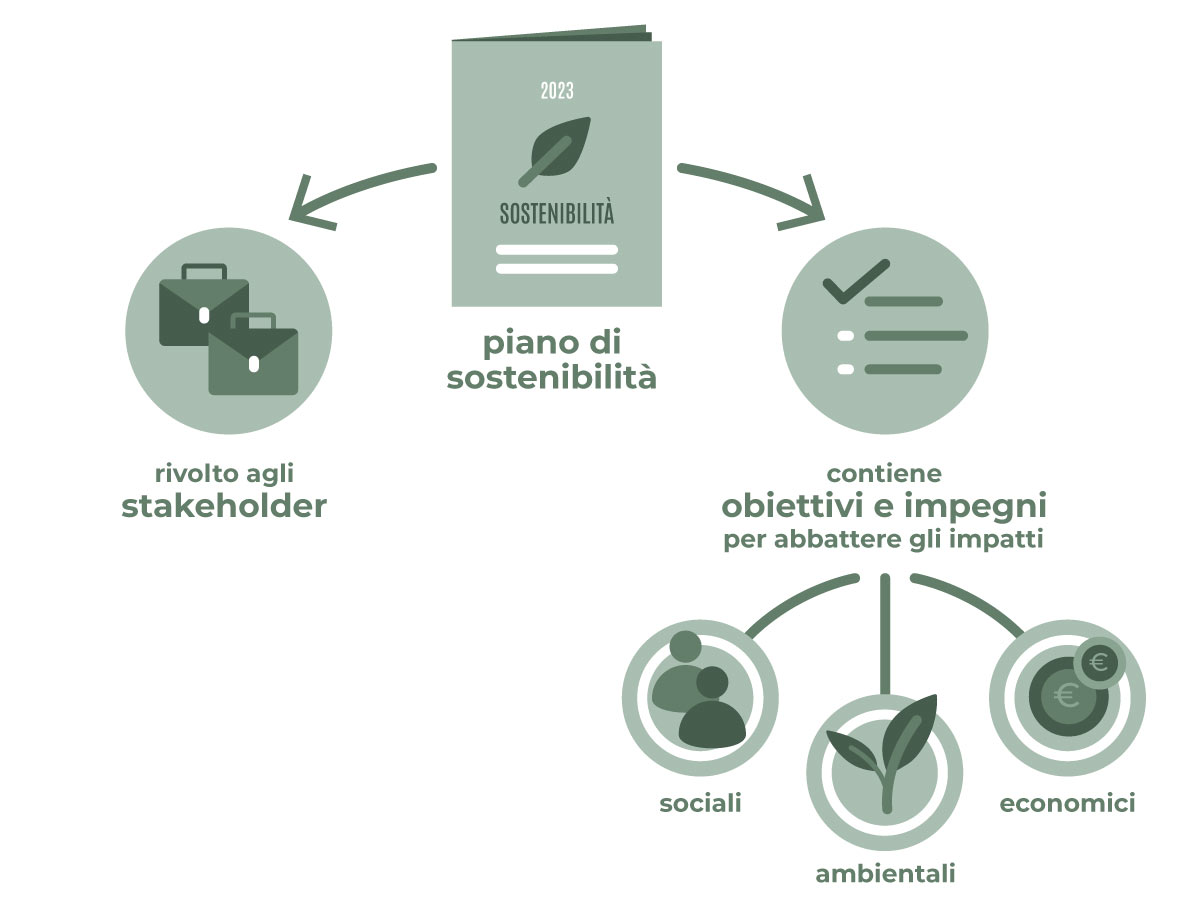The sustainability plan is one of the main tools through which companies demonstrate their commitment to integrating sustainability into their business. It is not just a statement of intent but a responsibility that brings out new growth opportunities and aligns their operations with the UN Sustainable Development Goals (SDGs). The sustainability plan is therefore useful in defining a strategy capable of establishing concrete actions based on business objectives, commitments undertaken, the stakeholders the company addresses, and the timelines it must adhere to.
Circularity and sustainability are topics strongly felt by consumers and institutions, who urge companies to take concrete action in this direction. It is therefore crucial for companies to adopt a decisive and consistent sustainable development approach.
1. What is a sustainability plan?
The sustainability plan is a document through which companies make their sustainability strategy known to internal and external stakeholders. Therefore, it is addressed to different types of subjects: employees, customers, interlocutors such as suppliers and investors, institutions and public bodies, etc. In the sustainability plan, the company outlines how it intends to articulate and/or remodulate its operations to minimize any potential source of negative impact.
It contains themes, objectives, initiatives, and activities that companies consider crucial in reducing their impact and improving their operations environmentally, socially, and economically. These activities are addressed to specific stakeholders (or groups of stakeholders), defining the methods and timelines useful for achieving them. The definition of the contents of the plan considers a medium to long-term time horizon and other factors such as the specificity of the case and the reference context. In this way, it is possible to guide the company in a gradual evolution towards sustainability, transforming it into a true strategic orientation.

2. What is the difference between a sustainability plan and a sustainability report?
It’s important not to confuse the sustainability plan with the sustainability report. The former, as already discussed, is a document through which to make sustainability strategy known to internal and external stakeholders. Therefore, initiatives and activities aimed at incorporating environmental sustainability into your business model to communicate them externally are outlined. The sustainability report (or sustainability balance) instead is a document used to measure and communicate an enterprise’s sustainability performance and impacts. The report thus allows greater transparency on risks, benefits, and impacts resulting from the company’s operations and performance relative to sustainable development objectives.
The main difference is that the plan, although adhering to CSR and SDGs logic, does not have well-defined regulations, while the report follows GRI standards for reporting and must be validated by a third party. The plan is updated annually to set new goals with a view to continuous improvement, while the report is drawn up each year.
In short, the first outlines a long-term strategy, whereas the second is a document for analyzing results. The two documents, therefore, work in synergy, and one does not exclude the other.
3. How is a sustainability plan created?
The development of a sustainability plan occurs through specific tools and activities. Usually, it is structured into a five-phase process, undertaken by a committee composed of key figures within the organization using the Circular Design Thinking methodology.
- Definition of internal and external stakeholders. Stakeholders, or interest parties, are the primary interlocutors with whom companies engage and the recipients of the plan. With the reconstruction of their relationship network, companies can more carefully plan their sustainability activities by identifying new opportunities for dialogue and value creation. This also applies to prioritizing actions and determining the subjects they are aimed at, considering opportunities for growth and sources of risk.
- Development of the materiality matrix. With this analysis, companies identify the “material” aspects related to sustainability that are most important to themselves and their stakeholders.
- Definition of pillars, objectives, and commitments. This involves establishing:
the principles forming the basis for business development that are the foundation for specific sustainability activities (the pillars);
the expected outcomes from the totality of various activities (the objectives);
the results aimed to be achieved with each planned activity (activities/commitments); - Alignment with the Sustainable Development Goals (SDGs). These are the seventeen goals defined by the UN that outline the path to follow for sustainable development. The presence of SDGs demonstrates the willingness of companies to participate and adhere to their realization.
- Drafting. The last phase is the preparation of the document to present to the stakeholders. It serves to clearly present an overall view of the ongoing processes and planned activities, as well as their details.
4. Analysis and planning in the sustainability plan
The creation of the sustainability plan enables companies to define and communicate the path they intend to follow toward sustainability. Thus, this principle becomes not a marginal or momentary trend but a true internal strategic orientation. This type of approach involves identifying objectives to be achieved through specific sustainability activities planned with consistency and coherence.
For them to be relevant from a sustainability standpoint, the objectives must follow the United Nations Sustainable Development Goals (SDGs). Furthermore, they must be measurable and allow in-progress evaluation of the results of activities outlined in the plan. Key performance indicators (KPIs), which track progress toward the achievement of a business goal, are essential here.

5. The role of CSR in the sustainability plan
An increasing number of companies are integrating the so-called Corporate Social Responsibility (CSR). It entails the assumption of responsibility for negative effects on society that may result from the company’s operations. This is in respect of the three dimensions of sustainability: environmental, social, and economic.
Through CSR, companies support the progress of the economic, social, and environmental systems in which they operate. For companies, this means defining actions, initiatives, and practices they commit to implementing internally and externally. This intention finds space in the corporate sustainability plan, which can act as an effective communication channel for CSR.
6. The benefits of the sustainability plan

The corporate sustainability plan benefits the social context in which companies operate, and the activities themselves gain significant advantages from its implementation.
- Increased efficiency of business performance, which may include:
– better cost management,
– more prudent use of means and resources available,
– improved control of potential problematic situations and transformations,
– higher quality of products and services. - Increased participation of all stakeholders, both internal and external, to companies.
- Positive effects on the company’s reputation.
- New opportunities for innovation, development, and economic benefits, as consumers increasingly seek companies aligned with their values and engaged in activities relevant to sustainability.
